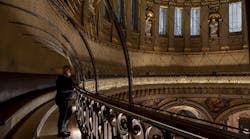LEDs Magazine reports short takes to put solid-state lighting and LED markets, R&D, applications, and business into perspective. This past week, Orion Energy revealed Q1 revenue and announced executive transition plans; Mount Sinai’s Light and Health Research Center teased a new research grant; and the first products to comply with the DesignLights Consortium LUNA environmental requirements land on the Qualified Products List.
Orion: Customer project delays impact Q1 financials
Commercial & industrial (C&I) lighting, controls, and services provider Orion Energy Systems has reported its fiscal 2023 first-quarter revenue (ended June 30, 2022). The company shared that its 1Q23 revenue was $17.9 million compared to $35.1 million a year ago, about a 50% decrease in revenue.
Orion CEO and board chair Mike Altschaefl said, “In Q1 23, we saw a continuation of customer project delays that also impacted our results in the second half of last year, along with some slowing of our sales cycle as new and existing customers work through current economic conditions.” Despite the slow start, he added, Orion foresees “a robust pipeline of opportunities” for the second half of the fiscal.
Altschaefl cited multiple strategies to diversify revenue sources, including building on sales and distribution channels, expanding lighting and electrical maintenance services through acquisitions, and nurturing relationships with energy services companies (ESCOs) to strengthen project opportunities.
Concurrently, Orion Energy Systems announced that Altschaefl will retire on Nov. 10, 2022, with executive vice president and COO Mike Jenkins stepping into the CEO role. Jenkins has been with the company since 2021 and will bring more than two decades of financial experience to the company leadership position. Altschaefl will remain on the board of directors through the company’s 2023 annual meeting; additional consulting opportunities are to be determined.
More details and links to a corporate webinar can be found in Orion Energy’s 1Q23 release.
LHRC investigates cardiometabolic connections
Your humble editor typically does not report on social media activity as “news,” but will make an exception in cases where the information comes straight from the source. The Light and Health Research Center (LHRC) at Mount Sinai’s Icahn School of Medicine has received a grant from the National Heart, Lung, and Blood Institute to research cardiac and metabolic (cardiometabolic) health and disease activity disparities based on differences in light–dark and rest–activity cycles. This solidifies comments from LHRC director Mariana Figueiro and program director Jennifer Brons in a December Q&A regarding the upcoming expansion of light and health studies and eligible resources under the larger health organization umbrella. See the embedded LinkedIn post from LHRC below. LEDs looks forward to connecting with the LHRC scientists to learn more about the studies as they progress.
DLC approves 18 products for LUNA outdoor requirements
After forming its Light Usage for Night Applications (LUNA) advisory group in early 2021, the DesignLights Consortium quickly moved ahead with drafting Technical Requirements for outdoor SSL products.
Back in the spring of 2021, DLC executive director Christina Halfpenny explained the urgency driving LUNA program development: “Light pollution in the form of sky glow, light trespass, and glare has been associated with a number of adverse impacts that affect people and wildlife and contribute to unnecessary energy costs and carbon emissions.”
With cooperation between representatives of DLC, the International Dark-Sky Association, Pacific Northwest National Laboratory, the International WELL Building Institute, the Illuminating Engineering Society, and industry firms Lighting Ideas, Inc. and Benya Burnett Consultants, DLC released Draft 2 for comment in September, announced the final version 1 in December, and moved to accepting applications from manufacturers seeking to qualify their products in April 2022.
White-light LED outdoor products on the LUNA QPL must not only meet the DLC’s SSL v5.1 efficacy requirements but comply with additional dimming, control, and shielding requirements for efficiency; light distribution, controls, and CCT specifications to decrease light trespass and sky glow; and still meet industry-prescribed light levels for human visual acuity.
The first LUNA listed products comprise 18 Cree Lighting LED luminaires — specific 3000K models in the XSPW Version B Wall Mount family. The outdoor luminaires were independently evaluated by an accredited laboratory and reviewed by DLC staff for inclusion.
“The addition of DLC’s LUNA program allows us to demonstrate to our customers and industry stakeholders that energy savings and reducing light pollution are not mutually exclusive,” said Jonathan Vollers, Cree Lighting director of engineering services. “We believe LUNA provides the industry with a complementary tool, along with good lighting design, to help achieve the IES and IDA’s Five Principles for Responsible Outdoor Lighting.”
Watch for an upcoming LEDs feature from the DLC on LUNA development and considerations for minimizing light pollution.
CARRIE MEADOWS is managing editor of LEDs Magazine, with 20 years’ experience in business-to-business publishing across technology markets including solid-state technology manufacturing, fiberoptic communications, machine vision, lasers and photonics, and LEDs and lighting.
For up-to-the-minute LED and SSL updates, follow us on Twitter. You’ll find curated content and commentary, as well as information on industry events, webcasts, and surveys on our LinkedIn page and our Facebook page.






